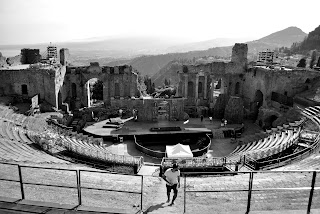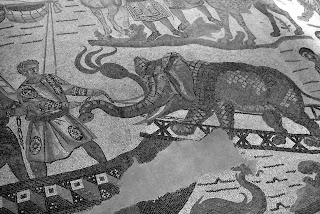We're heading to Messina, leaving Calabria at our back.
The time we have planned to spend in Sicily is 7/8 days.
Therefore, we decide to travel around the Eastern Sicily.
Once arrived in Messina, we drive straight to Taormina.
It's hot here. We are at the longitude of Maghreb.
So, before arriving at Taormina, which beach we imagine will be crowded, we stop by Santa Teresa di Riva (pictured).
I'll remember forever how hot was the gravel beach. In fact, I'm forced to dress my flip flop to walk around.
And what about that diaphanous sea? So fresh, so reinvigorating…
We are delighted to be here.
Additionally, there are free showers installed on free beach, available for anyone.
I pay great respect to that municipality, who provides free services to welcome travellers.
After having swum and sun bathed for a couple of hours, we resume our journey.
Once arrived in Taormina, I realise that the town is located on the mountain, not by the sea as I would have expected.
In order to visit Taormina, I am obliged to park the car in a multilevel car parking.
Then, we get the lift and reach the 7th floor.
Once out, Taormina discloses itself in front of our eyes.
Once out, Taormina discloses itself in front of our eyes.
Taormina is a so beautiful place to visit.
Indeed, Taormina is invaded by tourists, particularly by French, a constant in our journey.
From my perspective, the most beautiful thing to see in Taormina is the Greek theatre.

What awesome view: beyond the proscenium I see the Vulcan Etna on the right, whereas the sea is on the left.
Probably I had never seen anything like this before.
After having spent three hours there, we decide to move on.
It's 7 pm, we have booked a room in a B&B in Acireale, which is 45 kilometres away.
I drive, even though my mind has still impressed the bella Taormina and its amazing theatre.
We pass through Giardini Naxos, which is known to be the oldest Greek settlement in Sicily (8 century B.C.).
Then, we drive through Giarre. 15 more kilometres more and we reach Acireale.
Once there, we arrive at B&B, take a quick shower and get out looking for Baroque architecture to delight our eyes.
The rhythm of this holiday will always be like this: walking, driving, swimming, visiting museums, sleeping all over again…
It took me almost one week to fully recover after the journey.

The day after, we leave Acireale pretty early because we wish to see Aci trezza, the location where Giovanni Verga set his wonderful novel I Malavoglia.
We were expecting a village of fishermen untouched by modernity and concrete.
Unfortunately, the reality is different.

To console ourselves, we stop at a bar along the sea and have a granita al limone, a typical Sicilian one made with local lemons.
We don't want to waste time, so we quickly move to Catania, where we have booked a room in a B&B.
Catania is one of the greatest surprise of the trip.
Elegant, baroque, historical, alive and plenty of art.
We gain our room in Catania, rest for a while, take a shower and get out at 5 pm.
The city centre is amazing. An elephant dominates Piazza del Duomo, the main plaza in Catania.
What strikes me is the fact that an animal that lives in other continents turns to be the symbol of an European city.

50 metres far from the elephant, we find a monumental fountain made of Carrara marble.
It's called fontana dell'Amenano.
In Piazza San Francesco, 500 metres from Piazza del Duomo, there is a marvellous Greek-Roman theatre. It has been restored and re-opened a couple of months ago.
Catania seems to me a city where the local institutions work hard for the sake of community.

I found in Catania a place of book crossing made available by the municipality.
"We have started with a bunch of books, then people made this project growing by donating their own books. Currently, we have thousands of book. Anyone is welcome here and may exchange books" a lady says.

Another place worth to be seen in Catania is the fish market.
Try to be there at around 8.30/9 am.
We have little time because tonight we are going to sleep in Siracusa.
So, we quickly move on and go to see the Castle Ursino, which hosts a temporary paint exhibition on Madness, which encompasses so many Ligabue's paints.
We get out the Orsini castle and head to the Bellini theatre.

Bellini, born in Catania, died in France when he was 34 years.
The theatre, dedicated to the author of Norma, is just fantastic.
The ticket includes a guide who narrates its history.
Finally, due to limited time, we leave Catania not before having admired Palazzo Biscari, the most astonishing private palace of this astonishing city.

Even J. W. Goethe visited this palace during his journey to Italy
Our guide is actually a descendant of Prince of Biscari, who built it up after the earthquake of 1693.
The guide is called Ruggero Moncada di Paterno'.

He is an affable gentleman, who speaks Italian, French and English, according to the tourists he copes with.
We leave Catania which has impressed us a lot and head to Syracuse.
From an historical perspective, Syracuse was a powerful city which fought against Athens as well as Rome.
His most famous son is Archimedes, scientist and mathematician.
During the siege of Syracuse, Archimedes invented burning glass to set on fire the Roman ships.
Disgracefully, he was killed by a Roman butcher.
There is a lot to see in Syracuse.

The ancient part of the city is called Ortigia
In Ortigia you'll find the Santa Lucia's church hosting the Caravaggio's seppellimento di Santa Lucia.
If you go there and want to eat something unique, asks for pasta con le sarde.
Nevertheless, as sarda is an oily fish, bear in mind to not eat it for dinner as it requires a lot of time to be digested.
We visit the Syracuse archaeological park.
There is the Ara di Ierone as well as a huge Greek Theatre.

However, I believe the most fascinating thing to see is the Ear of Dionysius, a quarry which was so called by Caravaggio.
After having admired Syracuse, we move on and go to visit Ragusa, Modica and Noto, earth of Sicilian Baroque, An Unesco world heritage site.
In Ragusa, I have bought an interesting book called Storia di un amicizia, which talks about the meetings of a local photographer, Giuseppe Leone, with three Sicilians, who are among the greatest Italian writers: Leonardo Sciascia, Gesualdo Bufalino and Vincenzo Consolo.
If you wish to find out more about Sicily, and its contradictions, you must read the Sciascia's books.

During an interview, Leonardo Sciascia said "I have covered an institutional role both in the Municipality of Palermo and in the Italian Parliament. In both cases, I have always had the feeling that who rules is somewhere else, the decisions are taken outside the institutional sites".

Additionally, I wish to report what Gesualdo Bufalino said about mafia and how to fight it "books, books and again books! Plus, many teachers in primary schools".
The last thing I wish to talk about this wonderful journey, is the mosaic of the Roman Villa del Casale in Piazza Armerina.
This mosaic is famous all around the world both because of its magnificence and for being almost untouched.
The artists who made this amazing mosaic came from North Africa.
It took 50 years to complete it.
Basically, two generations, father and sons, have worked on it.
For all these reasons, Sicily may rightly be considered the ombellico del Mediterraneo.
The last thing I want to say about Sicily and its inhabitants is to highlight the humanity shown in handling the exodus from Africa.
The compassion of people in Lampedusa is well described by the documentary Fuocoammare, shot by Francesco Rosi, which has won the Berlin festival 2016.
Come to Sicily for a while in order to stay human.
It will be the antidote to these dehumanising times.
















No comments:
Post a Comment